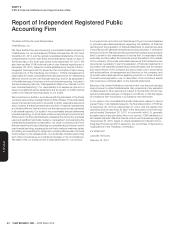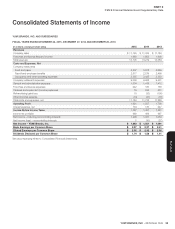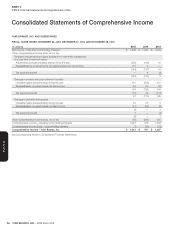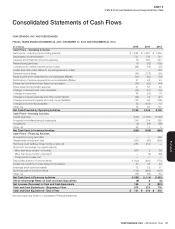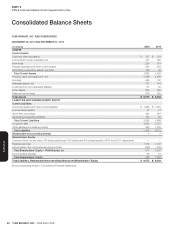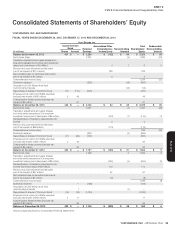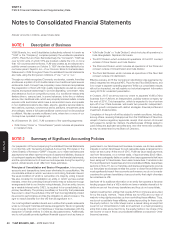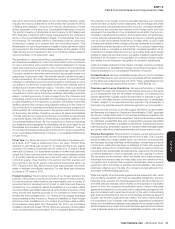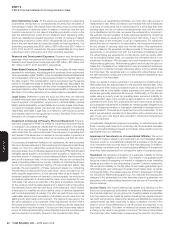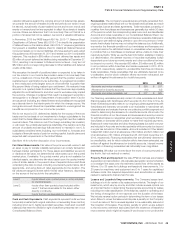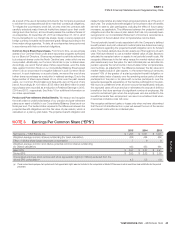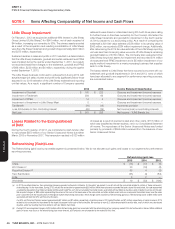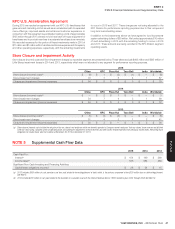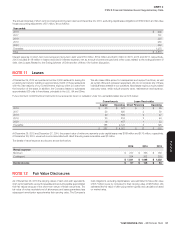Pizza Hut 2015 Annual Report Download - page 150
Download and view the complete annual report
Please find page 150 of the 2015 Pizza Hut annual report below. You can navigate through the pages in the report by either clicking on the pages listed below, or by using the keyword search tool below to find specific information within the annual report.
YUM! BRANDS, INC.-2015 Form10-K42
Form 10-K
PART II
ITEM 8Financial Statements and Supplementary Data
Direct Marketing Costs. To the extent we participate in advertising
cooperatives, we expense our contributions as incurred which are based on
a percentage of sales. We charge direct marketing costs incurred outside
of a cooperative to expense ratably in relation to revenues over the year
in which incurred and, in the case of advertising production costs, in the
year the advertisement is first shown. Deferred direct marketing costs,
which are classified as prepaid expenses, consist of media and related
advertising production costs which will generally be used for the first
time in the next fiscal year and have historically not been significant. Our
advertising expenses were $581 million, $589 million and $607 million in
2015, 2014 and 2013, respectively. We report substantially all of our direct
marketing costs in Occupancy and other operating expenses.
Research and Development Expenses. Research and development
expenses, which we expense as incurred, are reported in G&A expenses.
Research and development expenses were $28 million, $30 million and
$31 million in 2015, 2014 and 2013, respectively.
Share-Based Employee Compensation. We recognize all share-based
payments to employees, including grants of employee stock options and
stock appreciation rights (“SARs”), in the Consolidated Financial Statements
as compensation cost over the service period based on their fair value on
the date of grant. This compensation cost is recognized over the service
period on a straight-line basis for awards that actually vest. We present this
compensation cost consistent with the other compensation costs for the
employee recipient in either Payroll and employee benefits or G&A expenses.
See Note 14 for further discussion of our share-based compensation plans.
Legal Costs. Settlement costs are accrued when they are deemed
probable and reasonably estimable. Anticipated legal fees related to self-
insured workers’ compensation, employment practices liability, general
liability, automobile liability, product liability and property losses (collectively,
“property and casualty losses”) are accrued when deemed probable and
reasonably estimable. Legal fees not related to self-insured property
and casualty losses are recognized as incurred. See Note 18 for further
discussion of our legal proceedings.
Impairment or Disposal of Property, Plant and Equipment. Property,
plant and equipment (“PP&E”) is tested for impairment whenever events
or changes in circumstances indicate that the carrying value of the assets
may not be recoverable. The assets are not recoverable if their carrying
value is less than the undiscounted cash flows we expect to generate from
such assets. If the assets are not deemed to be recoverable, impairment is
measured based on the excess of their carrying value over their fair value.
For purposes of impairment testing for our restaurants, we have concluded
that an individual restaurant is the lowest level of independent cash flows
unless our intent is to refranchise restaurants as a group. We review our
long-lived assets of such individual restaurants (primarily PP&E and allocated
intangible assets subject to amortization) semi-annually for impairment, or
whenever events or changes in circumstances indicate that the carrying
amount of a restaurant may not be recoverable. We use two consecutive
years of operating losses as our primary indicator of potential impairment
for our semi-annual impairment testing of these restaurant assets. We
evaluate the recoverability of these restaurant assets by comparing
the estimated undiscounted future cash flows, which are based on our
entity-specific assumptions, to the carrying value of such assets. For
restaurant assets that are not deemed to be recoverable, we write-down
an impaired restaurant to its estimated fair value, which becomes its new
cost basis. Fair value is an estimate of the price a franchisee would pay
for the restaurant and its related assets and is determined by discounting
the estimated future after-tax cash flows of the restaurant, which include
a deduction for royalties we would receive under a franchise agreement
with terms substantially at market. The after-tax cash flows incorporate
reasonable assumptions we believe a franchisee would make such as
salesgrowth and margin improvement. The discount rate used in the
fair value calculation is our estimate of the required rate of return that a
franchisee would expect to receive when purchasing a similar restaurant
and the related long-lived assets. The discount rate incorporates rates of
returns for historical refranchising market transactions and is commensurate
with the risks and uncertainty inherent in the forecasted cash flows.
In executing our refranchising initiatives, we most often offer groups of
restaurants for sale. When we believe it is more likely than not a restaurant
or groups of restaurants will be refranchised for a price less than their
carrying value, but do not believe the restaurant(s) have met the criteria
to be classified as held for sale, we review the restaurants for impairment.
We evaluate the recoverability of these restaurant assets by comparing
estimated sales proceeds plus holding period cash flows, if any, to the
carrying value of the restaurant or group of restaurants. For restaurant
assets that are not deemed to be recoverable, we recognize impairment
for any excess of carrying value over the fair value of the restaurants,
which is based on the expected net sales proceeds. To the extent ongoing
agreements to be entered into with the franchisee simultaneous with
the refranchising are expected to contain terms, such as royalty rates,
not at prevailing market rates, we consider the off-market terms in our
impairment evaluation. We recognize any such impairment charges in
Refranchising (gain) loss. Refranchising (gain) loss includes the gains or
losses from the sales of our restaurants to new and existing franchisees,
including any impairment charges discussed above, and the related initial
franchise fees. We recognize gains on restaurant refranchisings when
the sale transaction closes and control of the restaurant operations have
transferred to the franchisee.
When we decide to close a restaurant, it is reviewed for impairment and
depreciable lives are adjusted based on the expected disposal date. Other
costs incurred when closing a restaurant such as costs of disposing of the
assets as well as other facility-related expenses from previously closed
stores are generally expensed as incurred. Additionally, at the date we
cease using a property under an operating lease, we record a liability for
the net present value of any remaining lease obligations, net of estimated
sublease income, if any. Any costs recorded upon store closure as well as
any subsequent adjustments to liabilities for remaining lease obligations as
a result of lease termination or changes in estimates of sublease income
are recorded in Closures and impairment (income) expenses. To the
extent we sell assets, primarily land, associated with a closed store, any
gain or loss upon that sale is also recorded in Closures and impairment
(income) expenses.
Considerable management judgment is necessary to estimate future cash
flows, including cash flows from continuing use, terminal value, sublease
income and refranchising proceeds. Accordingly, actual results could vary
significantly from our estimates.
Impairment of Investments in Unconsolidated Affiliates. We record
impairment charges related to an investment in an unconsolidated affiliate
whenever events or circumstances indicate that a decrease in the fair value
of an investment has occurred which is other than temporary. In addition,
we evaluate our investments in unconsolidated affiliates for impairment
when they have experienced two consecutive years of operating losses.
Guarantees. We recognize, at inception of a guarantee, a liability for the fair
value of certain obligations undertaken. The majority of our guarantees are
issued as a result of assigning our interest in obligations under operating
leases as a condition to the refranchising of certain Company restaurants.
We recognize a liability for the fair value of such lease guarantees upon
refranchising and upon subsequent renewals of such leases when we remain
contingently liable. The related expense and any subsequent changes
are included in Refranchising (gain) loss. Any expense and subsequent
changes in the guarantees for other franchise support guarantees not
associated with a refranchising transaction are included in Franchise and
license expense.
Income Taxes. We record deferred tax assets and liabilities for the
future tax consequences attributable to temporary differences between
the financial statement carrying amounts of existing assets and liabilities
and their respective tax bases as well as operating loss, capital loss and
tax credit carryforwards. Deferred tax assets and liabilities are measured
using enacted tax rates expected to apply to taxable income in the
years in which those differences or carryforwards are expected to be
recovered or settled. The effect on deferred tax assets and liabilities of
a change in tax rates is recognized in income in the period that includes
the enactment date. Additionally, in determining the need for recording a




